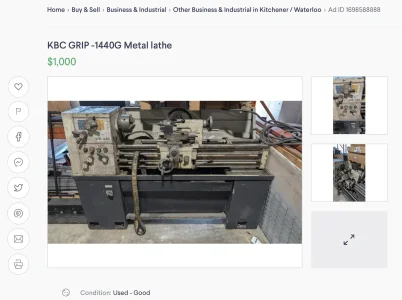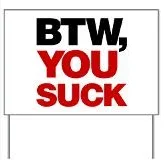PatrickT
Active Member
I thought it was another scam, but the gods of Kijiji took kindly on me today.
I'm now the proud owner of a KBC/YF 1440GH Precision lathe, and after getting to spend over two hours inspecting it, I can tell you this was an absolute dream come true. The seller was happy too, it's being transported out of his shop this week, freeing up some much needed space for his new equipment. He was convinced there was a broken gearbox due to a rattle, was very transparent about it, but for $1000, I couldn't resist. I gave him the cash as soon as I saw it, plus an extra $50 so I could spend time seeing what it would need for a rebuild, except..... IT DOESN'T!!
Just the tooling he included with it was worth more than what I paid. It belonged to his father in law, who passed not long after buying it, and sat in the back of the shop for several years, accumulating surface dust, and some shop rash from a few runs of small brass fittings.
Here's what I uncovered and verified:
-No broken gears; the lead screw gear under the driveline cover had just lost tensioning, creating a horrendous rattle. With a single bump of a mallet, the gears meshed perfectly and the drive sounds like glass.
-No rust or corrosion anywhere.
-Gearbox was low on oil, but it was very clean, with brass shavings from some small parts production accumulated in the recirculating catches.
-All gears shifted smoothly.
-Belts were mint.
-Lead screw & engagement shaft(?) still had packing coating on about 24" of each.
-Two handles had been taken off to stick on other machines, lead screw and tail stock tensioner. So they just weren't used at all. Found them in a box nearby.
-Spindle & Chuck: With a 12" X 1" piece of ground shaft in it, there was 0.00063 to 0.0002" runout, 8" from the chuck. I moved the bar twice to confirm this. After scouring off the dirt, the spindle showed 0.0001-0.0002" runout at the casting. There were absolutely no crash marks on the chuck, barely any nicks.
-Tailstock: When clamped, I could not get a variation screwing and unscrewing it. X or y. Nothing. I don't believe it was ever cranked out.
-Spindle is 1.5" ID, and ground on left side, plenty of clearance for a spider.
-All ways were impeccable, but covered in either shipping coating or a mud of white lithium with shop related grinding dust on top of it, but not in it.
-Wiring was mint, switches all functioned and felt like new.
-Paint was atrocious, but the seller said it had been covered in skids and shop junk for years, and flaked constantly, even during limited machining of brass. It looks like paint was used as a base coat, not primer, and you can scratch it off anywhere with a fingernail.
-Chip tray was bent from a hit by a moving dolly, but it was just some sheet metal flange, I'll fix that with a mallet in good time.
-Cross slide, Topside and Lead screw handles have little if any backlash. Like literally nothing. Smooth as glass.
-Gap had never been removed.
-Original oil in gearbox and cross slide, original stickers on everything.
Some features that really stood out:
Base is cast, the whole thing tipped the scales at 2980lbs, with little to no fluids in it. I was expecting 2000lb, as it was advertised.
Gears and ways are hardened.
Product of Taiwan.
Every bearing I could get my inspection camera on was stamped NTN or NTN KUWANA; I believe this explains the low spindle runout findings.
3HP 230V 3-phase motor.
19.5" from tips of the 3 jaw to the back end of spindle. With the cover modified, I'll have 3" exposed spindle for spiders etc.
So I scored gold. She'll get a shiny new epoxy paint job, new fluids and some great tooling, and a front row seat in my shop.

I'm now the proud owner of a KBC/YF 1440GH Precision lathe, and after getting to spend over two hours inspecting it, I can tell you this was an absolute dream come true. The seller was happy too, it's being transported out of his shop this week, freeing up some much needed space for his new equipment. He was convinced there was a broken gearbox due to a rattle, was very transparent about it, but for $1000, I couldn't resist. I gave him the cash as soon as I saw it, plus an extra $50 so I could spend time seeing what it would need for a rebuild, except..... IT DOESN'T!!
Just the tooling he included with it was worth more than what I paid. It belonged to his father in law, who passed not long after buying it, and sat in the back of the shop for several years, accumulating surface dust, and some shop rash from a few runs of small brass fittings.
Here's what I uncovered and verified:
-No broken gears; the lead screw gear under the driveline cover had just lost tensioning, creating a horrendous rattle. With a single bump of a mallet, the gears meshed perfectly and the drive sounds like glass.
-No rust or corrosion anywhere.
-Gearbox was low on oil, but it was very clean, with brass shavings from some small parts production accumulated in the recirculating catches.
-All gears shifted smoothly.
-Belts were mint.
-Lead screw & engagement shaft(?) still had packing coating on about 24" of each.
-Two handles had been taken off to stick on other machines, lead screw and tail stock tensioner. So they just weren't used at all. Found them in a box nearby.
-Spindle & Chuck: With a 12" X 1" piece of ground shaft in it, there was 0.00063 to 0.0002" runout, 8" from the chuck. I moved the bar twice to confirm this. After scouring off the dirt, the spindle showed 0.0001-0.0002" runout at the casting. There were absolutely no crash marks on the chuck, barely any nicks.
-Tailstock: When clamped, I could not get a variation screwing and unscrewing it. X or y. Nothing. I don't believe it was ever cranked out.
-Spindle is 1.5" ID, and ground on left side, plenty of clearance for a spider.
-All ways were impeccable, but covered in either shipping coating or a mud of white lithium with shop related grinding dust on top of it, but not in it.
-Wiring was mint, switches all functioned and felt like new.
-Paint was atrocious, but the seller said it had been covered in skids and shop junk for years, and flaked constantly, even during limited machining of brass. It looks like paint was used as a base coat, not primer, and you can scratch it off anywhere with a fingernail.
-Chip tray was bent from a hit by a moving dolly, but it was just some sheet metal flange, I'll fix that with a mallet in good time.
-Cross slide, Topside and Lead screw handles have little if any backlash. Like literally nothing. Smooth as glass.
-Gap had never been removed.
-Original oil in gearbox and cross slide, original stickers on everything.
Some features that really stood out:
Base is cast, the whole thing tipped the scales at 2980lbs, with little to no fluids in it. I was expecting 2000lb, as it was advertised.
Gears and ways are hardened.
Product of Taiwan.
Every bearing I could get my inspection camera on was stamped NTN or NTN KUWANA; I believe this explains the low spindle runout findings.
3HP 230V 3-phase motor.
19.5" from tips of the 3 jaw to the back end of spindle. With the cover modified, I'll have 3" exposed spindle for spiders etc.
So I scored gold. She'll get a shiny new epoxy paint job, new fluids and some great tooling, and a front row seat in my shop.




